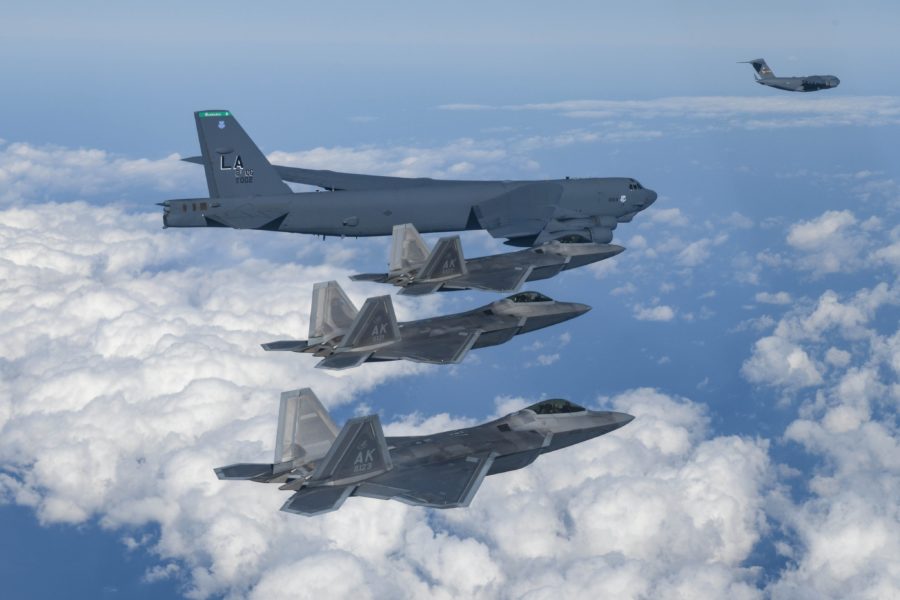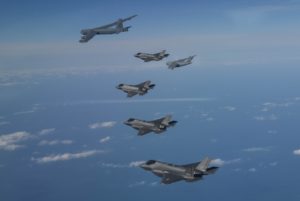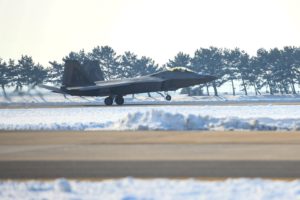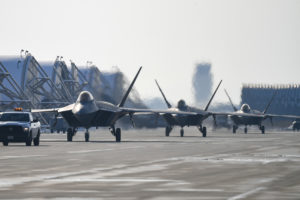American nuclear-capable bombers and U.S. and South Korean stealth fighters flew exercises in the skies around the Korean Peninsula on Dec. 20—the latest joint show of force by the allies after recent North Korean tests of missiles and a claimed spy satellite.
B-52 Stratofortresses from Barksdale Air Force Base, La., and F-22 Raptors from Kadena Air Base, Japan, joined South Korean F-35A Lightning IIs and F-15K Slam Eagles around Jeju Island south of the peninsula, South Korea’s military said, in an effort to increase the two militaries’ ability to respond to a North Korean attack.
South Korea added that the F-22s would stay at Kunsan Air Base in the country for the next week and train with South Korean F-35s. The F-22s recently deployed to Kadena on a rotational basis from Joint Base Elmendorf-Richardson, Alaska to take the place of aging F-15s there.
Pacific Air Forces, U.S. Forces Korea, and U.S. Indo-Pacific Command did not immediately respond to queries from Air & Space Forces Magazine.
Pentagon spokesperson Brig. Gen. Patrick S. Ryder noted the U.S. regularly exercises with South Korea in a Dec. 20 press briefing.
“We conduct a variety of exercises with our South Korean counterparts on a variety of capabilities—all designed to ensure interoperability and to signal to our partners in the region that we are a reliable ally, but also to potential aggressors in the region that we do maintain the capabilities to deter and if necessary respond,” Ryder said.
The U.S. has a policy of “extended deterrence” towards South Korea, meaning the U.S. would protect South Korea, officially known as the Republic of Korea (ROK), in the event of an attack by North Korea.
South Korea said the Dec. 20 exercise, which included the deployment of the nuclear-capable B-52, was part of a commitment the two countries made when South Korean defense minister Lee Jong-sup visited Secretary of Defense Lloyd J. Austin III in November. The two leaders said at the time they would increase the frequency of military exercises, which dropped off during the Trump administration.
“The ROK and the U.S. will continue to strengthen the alliance’s capabilities and posture, including extended deterrence, to further solidify the ROK-U.S. alliance’s combined defense posture against North Korean nuclear and missile threats,” South Korea’s defense ministry said.
On Dec. 17, North Korea conducted its latest ballistic missile tests. North Korea, officially the Democratic People’s Republic of Korea, also recently tested a solid-fuel rocket engine in a test personally overseen by Kim Jung Un, in the latest demonstration of North Korea’s advancing ballistic missile program. North Korea has launched a record number of missile tests in 2022, following Kim’s pledges that the state will field more advanced missiles and further develop its nuclear capabilities.
Meanwhile, the exercises involving the F-22s and B-52s are not the only recent ones conducted by the U.S. and South Korea.
U.S. Navy SEALs and South Korean special forces recently concluded a two-week exercise on Dec. 9, while the USS Ronald Reagan, based in Japan, recently returned to its home port after a nearly seven-month deployment, including exercises in the region alongside South Korean and Japanese forces.
South Korean warplanes dropped live weapons during a drill with American fighters in October after previous North Korean tests, and the U.S. and South Korea also conducted a large air exercise, Vigilant Storm, in November.
North Korea maintains the recent U.S. and allied military exercises in the region are provocative.





